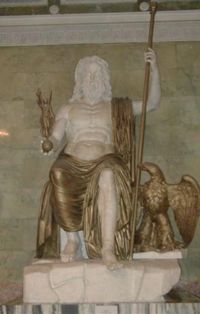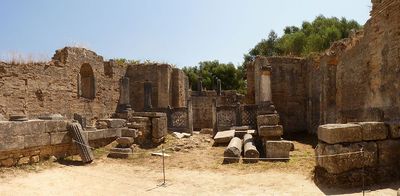Statue of Zeus at Olympia
 From Citizendium - Reading time: 3 min
From Citizendium - Reading time: 3 min

Statue of Zeus at Olympia, recreated for the Hermitage Museum
The Statue of Zeus at Olympia was built in the 5th century B.C. by Pheidias and was considered one of the Seven Wonders of the World.[1] Olympia was a centre for the worship of Zeus, and the statue renowned for its quality. It was about 13 metres tall and housed in a Temple of Zeus. The statue was destroyed in a fire in A.D. 462.
History[edit]
Olympia in the south of Greece was a sacred site to the ancient Greeks. It was a sanctuary of Zeus, king of the Greek pantheon of gods and the site of the Olympic Games, which honoured Zeus. According to tradition, the games began in 776 B.C., yet archaeologists have demonstrated there was ritual activity at Olympia pre-dating this, and over the centuries various buildings providing for pilgrims and religious activities were built. One such structure was the Temple of Zeus constructed between 466 B.C. and 456 B.C. (it would have looked something like the Parthenon which still stands in Athens).[2]

The remains of the "workshop of Pheidias" at Olympia
The temple was not intended to accommodate worshipers, but instead provide protection from weathering for religious paraphernalia. It is uncertain what this was to begin with, but it was replaced by a statue of Zeus. The sculptor Pheidias was commissioned to create the statue, and already had a reputation for work of outstanding quality. The Parthenon frieze may have counted among his works. The statue of Zeus was created by fixing ivory and gold to a wooden frame.[3]
According to the Suetonius biography of the Roman Emperor Caligula, who reigned between A.D. 37 and A.D. 41, Caligula gave orders for the Statue of Zeus at Olympia to be transported to Rome. However while the Romans were preparing to move the statue it laughed, scaring the workers away. In 391 A.D., paganism was outlawed in the Roman Empire, and the temple complex at Olympia fell out of use. The statue of Zeus was transported to Constantinople where it was displayed in a palace. However, the palace was consumed by fire in 462 A.D. and the statue was destroyed.[4]
Archaeological excavations at Olympia in 1958 discovered a workshop. Material dated to the 430s led to suggestions that the workshop may have been used by Pheidias himself, and this seemed to be confirmed when a cup with a Greek inscription reading "I belong to Pheidias" was discovered. However, the interpretation of the building has since been question and it may not have bee where the Statue of Zeus was worked on. Certainly, the workshop is too small to have held the completed statue.[5][6]
Appearance[edit]
As the original statue was destroyed in the 5th century and no copies survive, the main sources for the appearance of the statue of Zeus are the accounts of ancient authors and contemporary depictions on coinage. The coins show a seated figure holding a staff in one hand, while the descriptions provide more detail. Though Zeus was seated, he was so tall his head almost touched the roof of the temple. From a poem written by Callimachus in the 3rd century B.C., we know that the statue was about 13 metres (43 feet) tall.[7]
References[edit]
- ↑ Price, Martin J. (1988). "The Statue of Zeus at Olympia", in Peter A. Clayton and Martin J. Price (eds.) The Seven Wonders of the Ancient World. Routledge. p 62.
- ↑ Price, "The Statue of Zeus at Olympia", pp 59–61.
- ↑ Price, "The Statue of Zeus at Olympia", pp 62–63.
- ↑ Price, "The Statue of Zeus at Olympia", pp 76–77.
- ↑ Mattusch, Carol (1996). Classical Bronzes: The Art and Craft of Greek and Roman Statuary. Ithaca, New York: Cornell University. p 47. ISBN 9780801431821.
- ↑ Price, "The Statue of Zeus at Olympia", p 67.
- ↑ Price, "The Statue of Zeus at Olympia", pp 64–66, 76–77.
 KSF
KSF